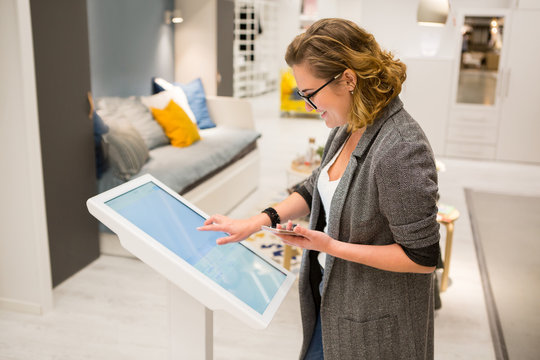Touch-screen technology has found use in devices ranging from cell phones to supermarket checkouts. While implementing an impression screen may involve additional expenses above other ways of input, it can provide some significant advantages. Before you implement touch displays in your business, consider the value they could bring to employees and customers alike.
Ease of Use
One major advantage touch screens have over other input methods is simplicity. As the usual blend of keyboard and mouse is familiar to most users, the practice of reaching out and touching icons on a screen comes intuitively even to those with out a computer background. A touch-screen interface can reduce training time for employees and empower customers to look up information or place orders themselves using self-service kiosks. Touch screens can even be an advantage to employees juggling multiple tasks, since a fairly easy touch-screen interface requires less concentration to use when compared to a mouse and keyboard.
Speed
Touch screens also raise the speed of tasks. When a user picks up a computer mouse or touches a trackball, there’s always a moment of uncertainty as he must locate the pointer, adapt his movements to match mouse acceleration and etc. Touch monitors allow users to pick out icons directly, without worrying about translating horizontal mouse movement to a vertical screen. A study by Mitsubishi Electric Research Laboratories indicated up to a 20 percent decrease in response time for users of touch-display systems pitched against a more traditional input method.
Device Size
By combining the data entry method with the display, you reduce the overall size of the computer or device. This advantage is most clear when it comes to lightweight devices, where smartphones and tablet PCs have long since eliminated attached, microscopic keyboards in favor of a fully touch-based interface. Even in the case of full-sized PCs, by using a touch screen makes it possible for you to set up systems in areas where space reaches a premium and decrease the range of components subjected to the user.
Assistive Technology
Touch screens are also valuable in accommodating users with physical problems that might make a traditional mouse and keyboard setup difficult to use. Users with arthritis, for instance, may have a problem manipulating a mouse or typing on a standard keyboard, making traditional computing tasks difficult. Directly accessing icons over a screen, however, may be easier for a user with physical challenges, especially when paired with a stylus or other pointing device to improve the interface.
